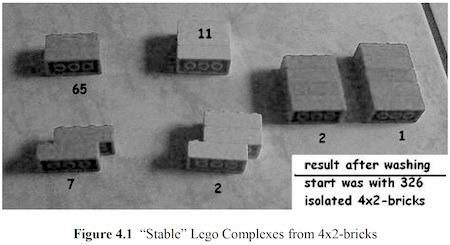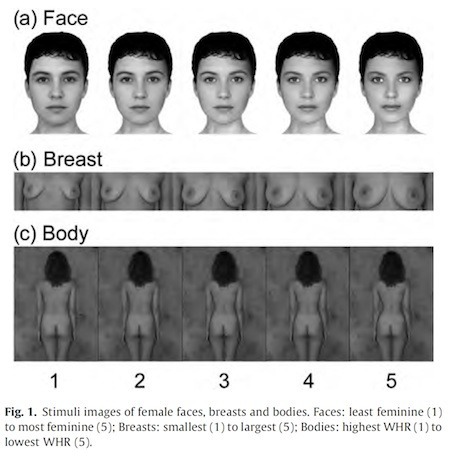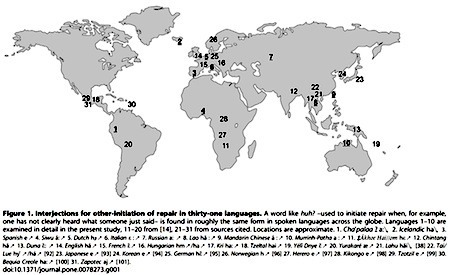Marc Abrahams's Blog, page 450
November 11, 2013
A washing machine filled with Legos and applied mathematics
Colin Lecher writes in Popular Science:
“Random Structures from Lego Bricks and Analog Monte Carlo Procedures” is… about throwing Legos in a washing machine. And it is wonderful.
Ingo Althöfer of Friedrich-Schiller University in Germany is the author of the minor masterpiece. From the introduction to the paper, allow Dr. Althöfer to explain:
Within a larger experimental series we put a whole bucket of old Lego(TM) bricks (from the late 1960′s and the early 1970′s) into our Miele(TM) washing machine [1]. The bricks were treated for 70 minutes, at 40 degree Celsius, without speed spinning at the end, without washing powder.
Yes! Good. But why do this? To see how many Lego(TM) bricks end up stuck together after they’ve all been spun, naturally. In other words–in the paper’s words–to see what “complexes arise” when you tumble those bricks…
Here’s detail from the study:
(Thanks to investigator Tom Ulrich for bringing this to our attention.)
BONUS (only slightly related): How to build a lego washing machine:

They seek a language for cheese
 The 21st century, at its birth, saw cheese researchers in something of a frenzy trying to solve the industry’s great language problem. The problem is this: say what you will, the taste of a cheese is hard to describe.
The 21st century, at its birth, saw cheese researchers in something of a frenzy trying to solve the industry’s great language problem. The problem is this: say what you will, the taste of a cheese is hard to describe.
This cheese – this one! – is better than the others, you insist. But how can you say why? Which words would cause competent cheesiasts, munching this same cheese and hearing you speak, to all agree?
Researchers chose to concentrate on cheddar. One must start somewhere.
In 2000, Jane Murray [pictured here, above] and Conor Delahunty [pictured here, below] of University College Cork rejected all earlier cheese-language-making attempts, complaining that “the method by which these were selected” was vague.
 Murray and Delahunty went at it with 25 volunteer taster/talkers and samples of Ballyclough cheddar, unislim reduced-fat cheddar-type, and other cheddary cheeses available in Ireland. Their resulting paper,Selection of Standards to Reference Terms in a Cheddar-Type Cheese Flavour Language, serves up a list of 21 terms to be used singly or in judicious combination: pungent, caramel, sweaty, creamy, fruity, buttery, rancid, cheddary, mushroom, mouldy, nutty, smokey, soapy, processed, sweet, salty, acidic, bitter, astringent and balanced….
Murray and Delahunty went at it with 25 volunteer taster/talkers and samples of Ballyclough cheddar, unislim reduced-fat cheddar-type, and other cheddary cheeses available in Ireland. Their resulting paper,Selection of Standards to Reference Terms in a Cheddar-Type Cheese Flavour Language, serves up a list of 21 terms to be used singly or in judicious combination: pungent, caramel, sweaty, creamy, fruity, buttery, rancid, cheddary, mushroom, mouldy, nutty, smokey, soapy, processed, sweet, salty, acidic, bitter, astringent and balanced….
—So begins this month’s Improbable Research column in The Guardian.

Simple answers to technology questions (XKCD)
Introducing a concept and/or a term: ‘Crazyism’
Just because the study of philosophy, metaphysics and ideologies goes back millennia, that doesn’t mean that there isn’t still room for a new ism. And one is envisioned in a new draft paper by professor Eric Schwitzgebel at the University of California, Riverside, US. He calls it “Crazyism”
“
Certain fundamental questions about the metaphysics of mind can’t, it seems, be settled by science, in anything like its current state, or by abstract reasoning. To address these questions we must turn to common sense. If we then have good reason to think that common sense, too, is no reliable guide, we are unmoored. Without common sense as a constraint, the possibilities open up, bizarre and beautiful in their different ways; and once open they refuse to shut. This is crazyism.”
The paper touches on aliens, zombies, bees, cats, quantum mechanics, and whether beer cans might feel pain. The full picture can be appreciated by reading ‘The Crazyist Metaphysics of Mind’ (June 2013)
Note : The professor has previously featured at Improbable : See:
Professorial Product Placement, and
Do ethicists steal more books (and stuff)?

November 10, 2013
Heated Girl-vs.-Girl Body-Parts Competition, Investigated by Scholars
Researchers in three countries went where their curiosity and/or other factors drove them, producing this study which, it says, is entirely about women:
“Female Physical Characteristics and Intra-Sexual Competition in Women,” Bernhard Fink [pictured here, above], Dominique Klappauf, Gayle Brewer [pictured here, at right], Todd K. Shackelford, Personality and Individual Differences, epub November 9, 2013. The authors, at the University of Göttingen, Germany, the University of Central Lancashire, UK, and Oakland University, Rochester, Minnesota, USA, explain:
“Women engage in intra-sexual competition to attract or to retain a mate. Given men’s preferences for certain female physical characteristics, women may be attuned to potential rivals who display such traits. We examined how variation in facial femininity, breast size, and waist-to-hip ratio (WHR) affects perceived competition and attractiveness judgments in a sample of German female undergraduates. Thirty-five women ranked five images of each stimulus type according to perceived competition and rated these images for attractiveness and femininity. Women with more feminine faces, larger breasts, and lower WHRs received higher attractiveness and femininity ratings and were ranked highest on perceived competition. The results indicate the occurrence of human female intra-sexual competition with respect to physical traits desired by potential mates.”
Here’s detail from the study:
(Thanks to investigator Enrique Grenados for bringing this to our attention.)
BONUS: Co-author Fink has published many studies investigating the significance of the relative lengths of a person’s 2nd finger and fourth finger.

November 9, 2013
Consternation about cleverness of humans & others
Some people tie themselves in knots, mentally, when they try to be clever about whether people and other animals are clever, is the gist of a study:
“Clever animals and killjoy explanations in comparative psychology,” Sara J. Shettleworth, Trends in Cognitive Science, Volume 14, Issue 11, November 2010, Pages 477-481. The author, at the university of Toronto, Canada, writes:
“From the process of organic evolution to the analysis of insect societies as self-organizing systems, biology is full of awe-inspiring examples of complexity arising from simplicity. Yet in the contemporary study of animal cognition, demonstrations that complex human-like behavior arises from simple mechanisms rather than from ‘higher’ processes, such as insight or theory of mind, are often seen as uninteresting and ‘killjoy’, almost a denial of mental continuity between other species and humans. At the same time, however, research elsewhere in psychology increasingly reveals an unexpected role in human behavior for simple, unconscious and sometimes irrational processes shared by other animals. Greater appreciation of such mechanisms in nonhuman species would contribute to a deeper, more truly comparative psychology.”
BONUS: Shettleworth cites, as the final item in her long list of references, a study by two Ig Nobel Prize winners:
Ghirlanda, S. and Enquist, M. (2003) “A century of generalization,” Anim. Behav. 66, 15–36.
Stefano Ghirlanda and Magnus Enquist (and colleague Liselotte Jansson) were awarded the 2003 Ig Nobel Prize in interdisciplinary studies for their report “Chickens Prefer Beautiful Humans.”

Huh here, Huh there, Huh everywhere?
It is universally appropriate to respond to news of this study by saying aloud the word “huh”, a close reading of the study suggests:
“Is ‘Huh?’ a Universal Word? Conversational Infrastructure and the Convergent Evolution of Linguistic Items,” Mark Dingemanse, Francisco Torreira, N.J. Enfield, PLoS ONE, 8(11), 2013, e78273. The authors, at Max Planck Institute for Psycholinguistics and Radboud University, both in Nijmegen, The Netherlands, explain:
“From a systematic comparison of 10 spoken languages [Cha'palaa, Dutch, Icelandic, Italian, Lao, Mandarin Chinese, Murriny Patha, Russian, Siwu, and Spanish] from 5 continents we find evidence suggesting that a word like ‘Huh?’–used as a ‘repair initiator’ when, for example, one has not clearly heard what someone just said–is a universal word. There are two distinct claims being made here: 1. that Huh? is universal, and 2. that Huh? is a word.”
Detail from the study:
(Thanks to investigator Gary Dryfoos for bringing this to our attention.)

Why does wine cry?
Invoking the interaction of differing surface tensions, Dan Quinn answers the question “Why Does Wine Cry”:
(HT Aatish Bhatia)
BONUS (unrelated, except in that it does involve both wine and crying, and someone who is interested in physics): Video of 22-year-old-physics student Daniel Murphy from Dublin crying wine:
BONUS (unrelated): Bobbejaan performs the song “I’m crying in my beer”:

November 8, 2013
A longer look at the Four-Legged Periodic Table Table
The American Chemical Society made this five-minute video essay about Theo Gray and his invention: four-legged periodic table table. The 2002 Ig Nobel Prize in chemistry honored the inventor and the invention:
BONUS: Theo Gray’s relatives’ “nauseatingly cute” version of Tom Lehrer’s classic song “The Elements”:

A Feminist Science Reading of Dr. Bodnar’s Ig Nobel Prize-Winning Emergency Bra
Public Health Striptease: A Feminist Science Reading of Dr. Bodnar’s Ig Nobel Prize-Winning Emergency Bra
Baltimore Under Ground Science Space, Baltimore, MD
Friday, November 15, 2013 from 7:00 PM to 8:30 PM (EST)
Well up pops Dr. Clare Jen, a researcher at UMd College Park based at Denisen U, wanting to interview the women at BUGSS in support of her project on “Women, Gender, and Making” (a particularly hot topic) After noticing that her scholarship seeks to connect women’s studies with science and health, I just could not resist asking her to give a talk.
In Dr. Jen’s words: “The Annals of Improbable Research awarded its 2009 Ig Nobel Prize Award in Public Health to Dr. Elena Bodnar for her invention of The Emergency Bra (EBbra)-a brassiere that quickly converts from bra cups into a pair of protective facemasks. Ig Nobel Prizes recognize “achievements that first make people laugh and then make them think.” This paper seriously considers this criteria: In what ways would Bodnar’s EBbra make a (post)feminist audience laugh and then think? This presentation offers close-readings of Bodnar’s Ig Nobel acceptance speech and invention demonstration. With a focus on the cultural politics of “silly sexy nerdy” humor, I ask whether the EBbra enacts a postfeminist sensibility and/or bears feminist possibilities.”
I think there is a fair chance of the unexpected. Yes, this is another free event (sort of. We could really use your donation) away from the ivory towers and other usual suspects. The public is welcome. RSVP
Here’s video of Dr. Bodnar’s acceptance speech:

Marc Abrahams's Blog
- Marc Abrahams's profile
- 14 followers










